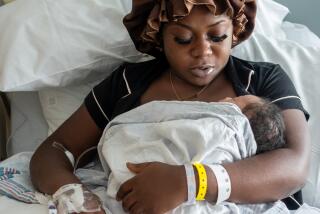Fetal Monitor : Device Gives Mothers-to-Be Edge on Births
- Share via
Twice a day, a pregnant Shawna Ramirez straps a six-sided piece of plastic to her bulging abdomen, lies down in bed and lets the device record information that could help her carry her baby through a healthy, full-term pregnancy.
The Cypress woman has reason to be concerned. Her first two children were born prematurely; her youngest, a 1-year-old boy, spent his first 19 days of life in an intensive-care ward because of problems brought on by his birth 5 1/2 weeks too soon.
“If I can hold off with this one for at least 36 weeks (the minimum for a full-term pregnancy), that would be great,” said Ramirez, who is seven months pregnant. “I want to be able to take my baby home with me instead of having to visit him in the hospital.”
At-Home Monitor
So for her third child, she uses an at-home fetal monitor developed and marketed by Tokos Medical Corp. of Santa Ana. The monitor is similar to ones used in hospitals and has been used by nearly 5,000 pregnant women across the country in a little more than a year.
The device measures uterine pressure and the non-painful, often unnoticeable contractions that, if excessive, can be a harbinger of premature labor. In many cases, by the time a woman feels she is having excessive contractions, it is too late to stop the labor, and her baby is born prematurely.
Premature birth is the leading cause of infant mortality in this country, authorities say. In addition, surviving premature babies are at risk for cerebral palsy, eye problems, neurological disorders and a number of other ailments.
“So if we could prevent prematurity, that would be a valuable, laudable thing to do,” said Dr. Roger Freeman, University of California, Irvine, professor of obstetrics and gynecology and a widely known authority on high-risk pregnancies.
Officials at Tokos (Greek for childbirth) believe that their monitor, called TermGuard, is an answer. But they have their skeptics, Freeman among them, who believe that the monitor’s benefits have not been sufficiently proved.
The monitor is for use in high-risk pregnancies. Among the indications of high risk are a history of pre-term labor or delivery, a previous second-trimester abortion, the expectation of multiple births and being the daughter of a woman who took diethylstilbestrol, or DES, a drug once used by pregnant women that has been linked to gynecological cancers and other problems in female offspring.
Called by Nurse
A woman using the Tokos program straps the monitor on for one hour in the morning and another hour at the end of the day. The woman is called by a nurse at one of Tokos’ 23 monitoring centers across the nation, then plugs her telephone into the monitor to transmit the two hours’ worth of data. About eight minutes later, the nurse has all the information, printed out on two-inch-wide graph paper, that enables her to count and time the contractions.
If there have been too many contractions--usually four an hour is considered “average”--the nurse may ask the woman to use the monitor again, and if the problem continues, the nurse will notify the woman’s doctor. The information can also be a tip-off as to whether the expectant mother has been neglecting or having problems with medication.
If excessive contractions continue, the doctor usually asks the mother to come in for a pelvic exam to determine whether her cervix has dilated. Cervical dilation, coupled with the accelerated uterine activity, means that pre-term labor has begun, said Vicki J. Grant, Tokos manager of marketing communications.
But if the labor is caught early enough, it can be stopped with drugs.
At Tokos’ headquarters, portraits of success stories--beaming parents holding healthy-looking babies--line the walls. The corporation is the business brainchild of R. Chuck David, an entrepreneur who had no medical background but who realized that the health-care industry’s new concern for cost controls could yield opportunities.
“So I tried to find a problem and a way to devise technology to serve that problem,” David said.
Physicians have made great advances in saving tiny newborns but at great financial cost, he said.
“So the question became how can we avoid all that and keep the fetuses in the womb longer?” he explained.
Tokos’ at-home monitor is not the only one on the market. PPG Biomedical Systems Inc. of Massachusetts markets Home Early Labor Predictor, or HELP, which debuted about a month before Tokos’ did. But HELP is merely a monitor that is sold directly to physicians’ offices and hospitals, which receive and analyze the uterine activity data, and does not offer Tokos’ 24-hour nursing services. A PPG spokesman said that about 2,500 women have used the HELP monitor nationwide.
Tokos’ program is not cheap. The cost is $75 a day.
Since many women begin using the monitor around the 20th to 24th week of their pregnancies, the bill can total $6,300 to $8,400 by the time the baby is delivered. But Tokos officials argue that those figures are far less than the bill for just a few days in a newborn intensive-care unit.
Medi-Cal will not pay for the monitor, David said, although several other states’ Medicaid programs do. However, Tokos’ Grant said the company is getting “lots of reimbursement from insurance companies because they see it as cost-effective.”
Accurate Information
Tokos officials are careful not to say that their product predicts or prevents pre-term labor. They do say that the product can provide timely and accurate information that enables the doctor to be alerted to a potential problem earlier, make a diagnosis and take action to stop the labor.
Tokos touts two studies of its product, one concluding that 88% of the monitored patients delivered full-term babies, the other finding that the monitor enabled physicians to better identify which patients needed drugs and allowed a greater percentage of women to carry their babies full term. About a dozen other studies are also in progress, David said.
One, conducted by Dr. Michael Katz at Children’s Hospital of San Francisco and the University of California, San Francisco, found that home monitoring “may indeed be useful in making the early diagnosis of pre-term labor.” In addition, Katz found that the babies of monitored women gained three to seven weeks in the womb after medication as contrasted with two to four weeks among unmonitored women.
But UCI’s Freeman, who is based at Memorial Medical Center of Long Beach, said a study he performed--to be presented next month at a meeting of the Society of Perinatal Obstetricians--casts doubt on how valuable the data gathered from the monitor is.
“I think this (monitor) is not ready to go on the road yet. We need more information,” Freeman said. “It’s a fascinating new subject. . . . But I’m a little afraid that the business has gotten ahead of the science.”
In his study, Freeman and his associates randomly assigned 150 women at risk for pre-term labor into three groups. The first group used the TermGuard monitor for two hours each day and phoned in their data, which was reviewed and used by their physicians. The second group likewise used the monitor and transmitted their data, but the information was filed away and ignored. The third group, the control group, was not monitored.
Less Premature Delivery
The study showed that all three groups experienced roughly the same incidence of premature labor, but the two groups that used the monitor had significantly less premature delivery.
The perplexing result, Freeman said, was that there was little difference between the first and second groups. The women whose uterine activity was scrutinized daily had essentially the same success rate as the women whose data was stashed away, he said.
“We were unable to show that the information gained was of any value,” he said.
“It’s possible that putting the device on the abdomen and lying down for an hour every day does it,” Freeman said. “I think there’s something there, I really do. But it’s confusing at this stage.”
Another physician involved in the study, Dr. Manuel Porto, UCI assistant professor of obstetrics and gynecology, said it is possible that the regular use of the monitor and the daily interaction by phone with a nurse made the patients in the second group become more aware of their contractions and other symptoms of premature labor, allowing them to bring the symptoms to the attention of their doctors in time for treatment.
“I think many patients felt contractions because they were tuned into them by wearing an elastic belt and the monitor,” Porto said.
Information Can’t Hurt
Still, Porto and Freeman do not condemn the TermGuard. Having daily information about a problem pregnancy cannot hurt, said Porto, who has some of his extremely high-risk pregnant patients in his private practice use the monitor.
Further, he said, there is nothing like the TermGuard to help a physician determine whether a patient is taking the proper dosage of drugs to ward off a recurrence of premature labor. Until the development of the at-home monitor, a physician had to monitor the woman’s side effects--such as an elevated heart rate--to figure out the proper dosage. The monitor also will detect if the patients have skipped or altered their medication, which “doesn’t make them feel too good.”
“It serves as a lie detector,” he said.
“At least at this point,” Porto said, “the main objection is it’s very expensive. If it prevents pre-term birth, it’s cost-effective, but maybe there’s a cheaper way of doing it.”
Tokos founder David said Freeman’s study tested only the monitor, took all transmissions between the hours of 8 a.m. to 5 p.m. and did not use Tokos’ nursing service.
“It is very well documented that uterine irritability and activity increases dramatically at night,” he said, adding that 30% to 40% of the women using the monitor who have gone into pre-term labor did so at night.
Both Convinced
Ramirez has a good six weeks left in her pregnancy, if all goes well, and the monitor has already helped her doctor catch one onset of premature labor in time to stop it. Ramirez was hospitalized in early January for treatment, and both doctor and patient are convinced that without the monitor, Ramirez would already have delivered a premature, undersize--and undoubtedly desperately ill--baby.
“Oh yes, no question about it,” said Dr. Peter Anzaldo of Orange. “Without the monitor, I think she probably wouldn’t have called and been aware (of the contractions) as early as she did. And she would have had the baby . . . about a two-pound baby.”






